www.thornwalker.com/ditch/pearl.htm
Pearl
Harbor: facing facts
By Dr. STEPHEN J.
SNIEGOSKI
The Establishment defense of Franklin Roosevelt's
policies leading up to the attack on Pearl Harbor
typically deals with key arguments of revisionists by
ignoring them. That was certainly the case with the
History Channel's recent documentary "Tora, Tora,
Tora," and it seems to be reflected in the cinematic
special-effects blockbuster "Pearl Harbor."
The legend pushed by courtier historians, picked up by
the low-brow media and entertainment industries, is that
the United States was minding her own business until
the mad Japanese launched their unprovoked attack,
dragging reluctant Americans into a terrible world war
and thereby obliging the United States to shoulder
"international responsibilities" as world judge and
policeman. In reality, the United States had been deeply
involved in Far East affairs for some time, and her
policies actually provoked the Japanese attack at Pearl
Harbor.
Washington had sought to prevent Japanese expansion
in China for many years. By 1940, the United States was
providing support for China, which was at war with Japan,
in the form of a $25 million loan. In 1941, the Roosevelt
regime extended lend-lease to China, which enabled
China to receive American war materials without
requiring payment. The U.S. government covertly
sponsored an American-manned air force for China
— General Claire Chennault's "Flying Tigers." The
unit was advertised as being manned by "volunteers,"
but actually it was closely connected to the American
military — paralleling the Chinese Communist
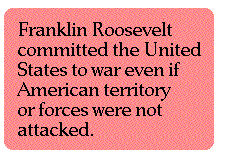 "volunteers" who
intervened in the Korean War. In mid 1941 the U.S.
Army prepared to send a second "voluntary" air group to
China equipped with B-17s that could carry out strategic
bombing of Japan — paralleling the Soviets'
installing missiles in Cuba to protect Castro. U.S. aid to
China had the effect of stiffening Chinese resistance and
precluding any peace settlement that would favor
Japan.
"volunteers" who
intervened in the Korean War. In mid 1941 the U.S.
Army prepared to send a second "voluntary" air group to
China equipped with B-17s that could carry out strategic
bombing of Japan — paralleling the Soviets'
installing missiles in Cuba to protect Castro. U.S. aid to
China had the effect of stiffening Chinese resistance and
precluding any peace settlement that would favor
Japan.
Meanwhile in 1941, the United States had been making
secret military plans with the British and Dutch. Between
January and March, joint staff conferences between the
Americans and the British took place in Washington.
They were extended in April to include the Dutch, in
meetings held in Singapore. Out of the discussions came
the ABD agreement, committing the conferees to jointly
fight the Japanese in Asia if Japanese forces crossed the
geographical line of 100° East and 10° North,
which approximated the northern extremity of the Dutch East Indies. The
agreement covered Japanese movement into neutral
Thailand as well as invasions of British and Dutch
colonial possessions. In these secret agreements,
unknown to either Congress or the American people,
Franklin Roosevelt committed the United States to
war even if American territory or forces were not
attacked.
Though the agreements were only verbal, the British and
Dutch took them as an irreversible commitment, while
the U.S. armed forces drew up a war plan in harmony
with them that became known as WPL 46. The overall
agreement was known as Rainbow 5; the part involving
the Dutch was known as Rainbow (A-2). The war plans of
the Americans, British, and Dutch were predicated on
going to war if Japan moved southward.
When the Japanese actually crossed the prescribed
geographical line on December 4, three days before
Pearl Harbor, the Dutch implemented the ABD and
Rainbow-5 (A-2) plans and expectantly awaited the
promised help from the U.S. Navy in repelling the
Japanese incursion. Thus, Americans became involved
in the Pacific phase of World War II whether they
approved of it or not. That the general public knew
nothing of the pact and that the Roosevelt regime did
not actually sign any documents involving
the United States are irrelevant; the other signatories
took it very seriously and expected Washington to honor
the commitment. (See James J. Martin, "Pearl Harbor:
Antecedents, Background and Consequences.")
The Dutch exile regime (their homeland was occupied
by the Germans) obviously believed the United States
would back them up: they would not dare face the
mighty Japanese military by themselves. It must be
emphasized again — according to the wording of
Roosevelt's secret commitment and the war plan based
on it, the United States was at war with Japan, de facto,
before the Pearl Harbor attack even occurred.
Now, of course, according to the U.S. Constitution, the
United States was not at war as a result
of Roosevelt's secret commitment. In order to carry out his
war commitment, Roosevelt desperately needed an
incident with Japan that would win him public support. A
declaration of war to stop Japanese aggression
southward — in the absence of an attack on
American colonial possessions or on American forces
— would have been difficult, perhaps politically
impossible. There would have been strong public
opposition to such a war. An incident was necessary to
unify the country. That is why, from Roosevelt's
standpoint, the attack on Pearl Harbor was a godsend.
But that is not to say the attack came out of the blue,
given what the Japanese knew of American aims and
strategy, and what they saw American policy doing to
them.
Roosevelt's secret commitment. In order to carry out his
war commitment, Roosevelt desperately needed an
incident with Japan that would win him public support. A
declaration of war to stop Japanese aggression
southward — in the absence of an attack on
American colonial possessions or on American forces
— would have been difficult, perhaps politically
impossible. There would have been strong public
opposition to such a war. An incident was necessary to
unify the country. That is why, from Roosevelt's
standpoint, the attack on Pearl Harbor was a godsend.
But that is not to say the attack came out of the blue,
given what the Japanese knew of American aims and
strategy, and what they saw American policy doing to
them.
***
The United States had been building up her military
strength in the Far East in addition to her false-flag
bomber force in China. In 1940, Roosevelt ordered the
Pacific Fleet to move from its permanent base in San
Diego to Pearl Harbor. The American fleet combined
with the British fleet in the Pacific was superior to that of
the Japanese.
By the fall of 1941 the development of a B-17 bomber
force in the Philippines had been awarded precedence
over the fleet as the means of deterring Japanese
expansionism. Its purpose could be construed as
offensive as well as deterrent since the Americans were
thinking in terms of bombing Japanese cities. In
September 1941, the ABD conferees in Singapore sent a
Top Secret memo to General MacArthur in Manila that
underscored the fact that American forces and resources
could be used for offensive purposes. Among its
provisions:
Create subversive organizations in the
China coast ports, and in French Indo-China. These
must commence operation as soon as possible
concentrating on propaganda, terrorism, and sabotage
of Japanese communications and military
installations....
... Assassination of individual Japanese should also be
considered.
... Prepare to defeat Japan without suffering grievous loss
ourselves.... We must base mobile forces as near to
Japan as is practicable.... To the west there is China
where air bases are already being prepared and
stocked.... To the south there is Luzon in the Philippine
Islands, within easy air range of Hainan, Formosa, and
Canton, and extreme range of southern Japan....
Development of further air bases is proceeding. [1]
Historian Robert Smith Thompson outlines the
American, British, and Dutch plan for an offensive 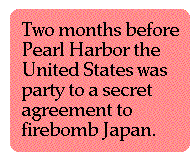 contained in the
memo: "First, the ABD powers intended to confine Japan
'as nearly as possible to the defense of her main islands.'
Second, they proposed to 'cut Japan off from all sea
communications with China and the outside world by
intensive action in the air and waters around Japan, and
to destroy by air attack her war industries.' Two months
before the Pearl Harbor attack, that is, the United States
of America was party to a secret international agreement
to firebomb Japan." [2]
contained in the
memo: "First, the ABD powers intended to confine Japan
'as nearly as possible to the defense of her main islands.'
Second, they proposed to 'cut Japan off from all sea
communications with China and the outside world by
intensive action in the air and waters around Japan, and
to destroy by air attack her war industries.' Two months
before the Pearl Harbor attack, that is, the United States
of America was party to a secret international agreement
to firebomb Japan." [2]
Thompson's last point needs repeating, and it needs
emphasizing: Two months before Pearl Harbor the
United States was party to a secret agreement to
firebomb Japan.
Later in his book, Thompson illustrates how the ABD
plan for offensive action against Japan was leaked to the
press.
***
In July 1941, Japanese forces completed their occupation
of French Indo-China. Allegedly in retaliation, Roosevelt
announced his most drastic measure to date: He froze all
Japanese assets in the United States. That deprived the
Japanese of the means to purchase American goods, the
most critical of which was oil. (Roosevelt had considered
the move prior to the latest Japanese aggression.) The
British and Free Dutch governments followed suit. Japan
had to import all of her oil: neither Japan nor the
Japanese-controlled areas in China produced any. Japan
relied on the United States for all but 2 percent of her oil
supply. The mechanized elements of the Japanese army
required oil to function; without oil, Japan would be
unable to continue her war in China. The United States
(and the British and Dutch) made it clear to the
Japanese that the oil embargo would be relaxed only in
exchange for an end to Japanese involvement in China.
In its July 27 issue the New York Times referred to
Roosevelt's action as "the most drastic blow short of
war."
All factions of the Japanese government —
moderates as well as extremists — believed that
complete abandonment of their position in China was
unacceptable. Backing down, they held, would destroy
Japan's status as a great power and would be ruinous
economically. But without oil, Japan would ultimately be
militarily helpless in her own backyard, given the rising
strength of the Anglo-American alliance.
To continue prosecuting the war in China, Japan
required oil and other natural resources blocked by the
embargo. Thus the Japanese felt they had to seize
Thailand, British Malaya, and the Dutch East Indies
where those resources were situated. And they would
have to attack soon: the Japanese Navy was warning that
its fuel supplies were running low.
***
The militant Japanese reaction was expected by
Washington and feared by American military leaders
who wanted to postpone war for some time. Six days
before Roosevelt's assets-freeze, Admiral Richmond
Kelly Turner, Navy chief of war plans, presented a report
to the president on the probable consequences of
imposing an oil embargo on Japan. Turner
wrote:
It is generally believed that shutting off the American
supply of petroleum will lead promptly to an invasion of
the Netherlands East Indies.... An embargo on exports
will have an immediate severe psychological reaction in
Japan against the United States. It is almost certain to
intensify the determination of those now in power to
continue their present course. Furthermore, it seems
certain that, if Japan should then take military measures
against the British and Dutch, she would also include
military action against the Philippines, which would
immediately involve us in a Pacific
war.
According to Japanese calculations the United States
would go to war against them if they attacked British or
Dutch territory. Tokyo saw the U.S. Pacific Fleet
stationed at Pearl Harbor as a significant threat to its
military policy. The Japanese understood, too, that U.S.
bomber forces could operate against them from the
Philippines. American forces could strike at Japan's
exposed left flank as she drove south, fatally disrupting
the required quick takeover of Southeast Asia. The ABD
talks were not so secret that the Japanese did not get
wind of them, and they comported with other evidence
that the United States would support the British and the
Dutch in militarily opposing any Japanese move
southward to obtain the vital oil. On December 3, 1941,
the Japanese Embassy in Washington cabled Tokyo:
"Judging from indications, we feel that some joint
military action between Great Britain and the United
States, with or without a declaration of war, is a definite
certainty in the event of [a Japanese] occupation of
Thailand."[3]
That meant that 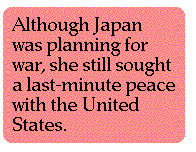 if Japan wanted to
acquire the resources of Southeast Asia she would have
to strike a pre-emptive blow against American power. As
Robert Smith Thompson writes: "The implication was
clear. Japan's only salvation lay in taking out the United
States Pacific fleet, wherever it lay." (p. 379)
Neutralization of American offensive power in the
Philippines was another necessary objective.
if Japan wanted to
acquire the resources of Southeast Asia she would have
to strike a pre-emptive blow against American power. As
Robert Smith Thompson writes: "The implication was
clear. Japan's only salvation lay in taking out the United
States Pacific fleet, wherever it lay." (p. 379)
Neutralization of American offensive power in the
Philippines was another necessary objective.
Japan's military leadership realized that the military
potential of the United States was much superior to their
own and looked to war only because there seemed to be
no other alternative. Tokyo's aims in striking at the
United States were limited: to destroy existing American
offensive capabilities in the Pacific by tactical surprise.
The Imperial Military High Command hoped only to
give its forces time to occupy the islands of the Southwest
Pacific, to extract those islands' raw materials, and to
turn the whole area into a virtually impregnable line of
defense that could long delay an American
counteroffensive.
***
Although Japan was planning for war, she still sought a
last-minute peace with the United States. War would be
the instrument of the last resort if Japan was unable to
get trade with the United States restored by diplomatic
means. Tokyo sent senior diplomats to Washington in an
effort to achieve peace and more-normal relations. In
August 1941, Prime Minister Prince Konoye even offered
to meet President Roosevelt in Washington to negotiate
in an effort to prevent war. Roosevelt rejected Konoye's
offer. Soon afterward, Konoye's moderate government
fell from power and was replaced by a more militant
group headed by General Hideki Tojo. That clearly
signaled a further step toward war.
However, Tokyo still sought to negotiate. Japan was
willing to promise the United States that she would pull
out of Indo-China and refrain from joining Germany in
an offensive war. In return the United States would be
expected to stop backing China and to encourage the
Chinese government to negotiate with the Japanese. The
United States refused to accept the Japanese offers and
demanded that Japan withdraw her army from China
and respect China's territorial integrity.
Japan continued to seek a diplomatic solution in
November as she prepared to attack. American
intelligence had broken the Japanese diplomatic code,
and the American leadership was aware that, if no
solution was reached, then Japan would go to war.
However, the only conciliatory move the Roosevelt
administration ever considered making was a "modus
vivendi," which would have been a temporary
arrangement. Military leaders in Washington wanted to
avoid war until America had increased her strength in
the Far East. The modus vivendi would have entailed
mutual American and Japanese pledges against
aggressive moves in the Pacific; Japan would withdraw
from southern Indo-China and limit her troops in the
north. In return the United States would supply Japan
with limited supplies of oil and other materials.
The Roosevelt regime ultimately rejected the
modus vivendi on November 27 and instead offered its
"10-point proposal." Under its provisions, Japan would
have to withdraw all military forces from China and
Indo-China. Japan regarded the proposal as an insult
and completely unacceptable.
The U.S. rejection of any compromise that would provide
Japan with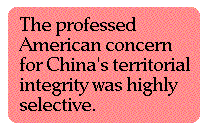 oil convinced Tokyo that Japan would have to
seize oil resources by force.
Despite the breaking of the Japanese code and their
knowledge that Japan would now initiate war, U.S.
government leaders were still not certain that the United
States would be a target. Revisionist historians differ on
this point. Some hold that although Roosevelt had
information that the Japanese would attack American
territory, including Pearl Harbor, he still feared that the
Japanese might avoid a direct attack — that, at least,
he was not certain until shortly before the actual
attack.
oil convinced Tokyo that Japan would have to
seize oil resources by force.
Despite the breaking of the Japanese code and their
knowledge that Japan would now initiate war, U.S.
government leaders were still not certain that the United
States would be a target. Revisionist historians differ on
this point. Some hold that although Roosevelt had
information that the Japanese would attack American
territory, including Pearl Harbor, he still feared that the
Japanese might avoid a direct attack — that, at least,
he was not certain until shortly before the actual
attack.
***
On the surface, it would seem that the United States
pursued a policy that led to war in order to preserve the
territorial integrity of China. Since it is generally believed
that states should make war only to protect their own
national security, the preservation of Chinese territorial
integrity should strike most people as an odd reason for
which to go to war. Moreover, it should be pointed out
that the professed American concern for China's
territorial integrity was highly selective. Washington
never criticized the Soviet Union for detaching Outer
Mongolia in the 1920s (making it a satellite) or for
establishing control over China's Sinkiang province in
the 1930s. For that matter, near the end of World War II
the United States herself violated Chinese sovereignty in
the Yalta Accord, which awarded the Soviet Union
various rights in Manchuria.
Perhaps it was not the defense of China that motivated
American policy toward Japan. Revisionists claim that
Roosevelt was actually pursuing a "Back Door to War"
approach, intending that war with Japan should lead to
war with Germany. That did occur, but critics point out
that Germany was not obliged to declare war since
Japan, not the United States, launched the attack.
However, according to John Costello in The Pacific
War, Churchill in the fall of 1941 had
decoded a message from Hitler in which he stated that
he would declare war on the United States if Japan and
the United States went to war — that is to say, even if
Tokyo struck first. And Churchill passed that intercept on
to Roosevelt. In any case, it was widely believed in the
United States that Germany and Japan worked closely
together. Consequently, war with Japan would make it
easier for Roosevelt to achieve a declaration of war on
Germany.
Influencing overall American hard-line policy toward
Japan, perhaps crucially, was the desire to bolster the
Soviet Union. Roosevelt saw the Soviet Union's survival,
which was still uncertain in the fall of 1941, as necessary
for defeating Germany. At that time, Japan still had not
abandoned her plan to attack Russia, which in the late
1930s had humiliated her in an undeclared war. The
leadership in Tokyo was still debating whether to move
north or south. If the Japanese war with China was settled
and the embargo on oil was lifted, it would be easier for
Japan to attack the Soviets. It is apparent that
American Communists who held important positions in
the Roosevelt administration, such as Harry Dexter
White, wanted America to pursue a hard line with Japan
in order to protect the Soviet Union. Maybe that was
Roosevelt's principal motivation as well.
The Soviets, for their part, worked to guarantee a war
between Japan and the West to prevent any Japanese
attack on the Soviet Far East. White, assistant secretary of the treasury, was the key Soviet spy in the U.S. government, and he consciously served
Moscow's strategy — the "Operation Snow" plan — in agitating for American brinksmanship against Japan. That the Soviet Union and
her agents acted to foster U.S. involvement in the war is
demonstrated by Anthony Kubek in his excellent book,
How the Far East Was Lost. [4] Recent revelations from
the Venona files by Herbert Romerstein and Eric Breindel [5] and by John Earl
Haynes and Harvey Klehr [6] have confirmed Kubek's analysis.
Many revisionists would argue that Roosevelt did not
need the push from Soviet spies to motivate his pro-war
policy, but it is hard to deny that they were a
contributing factor. And conceivably Roosevelt took a
harder line in November 1941 — rejecting the
proposed modus vivendi with Japan — to aid the
interests of the Soviet Union.
***
While the movie "Pearl Harbor" omits Roosevelt's
machinations, Official Conservatives are outraged that it
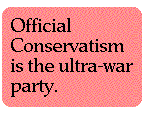 is insufficiently
anti-Japanese. Presumably they would prefer something
resembling the old movies and cartoons with cringing,
buck-toothed, bespectacled little "Nips" mouthing the
words "so solly" after being caught performing some
devilish deed. But that is what Official Conservatism is
all about today. It is the ultra-war party. It wants to beef
up the military to enhance America's global imperialism.
It wants to prevent the United States from slumbering in
"isolationism" while some evil nation prepares to launch
a "sneak" attack. That is the lesson of Pearl Harbor that
Official Conservatives want to teach. It should surprise
no one that the Official Conservatives of the mature
American Empire consider Franklin Delano Roosevelt
one of their greatest heroes; his legacy is a large part of
what they seek to conserve.
is insufficiently
anti-Japanese. Presumably they would prefer something
resembling the old movies and cartoons with cringing,
buck-toothed, bespectacled little "Nips" mouthing the
words "so solly" after being caught performing some
devilish deed. But that is what Official Conservatism is
all about today. It is the ultra-war party. It wants to beef
up the military to enhance America's global imperialism.
It wants to prevent the United States from slumbering in
"isolationism" while some evil nation prepares to launch
a "sneak" attack. That is the lesson of Pearl Harbor that
Official Conservatives want to teach. It should surprise
no one that the Official Conservatives of the mature
American Empire consider Franklin Delano Roosevelt
one of their greatest heroes; his legacy is a large part of
what they seek to conserve.
The Japanese assumption that the United States would
go to war against them was based on fact. The attack on
Pearl Harbor, godsend for Roosevelt that it was, did
not come out of  the blue, nor was it the
result of the evil nature of the Japanese militarists. The
Japanese attacked because they knew that the United
States planned to attack them, and they deemed it
necessary to get in the first blow.
the blue, nor was it the
result of the evil nature of the Japanese militarists. The
Japanese attacked because they knew that the United
States planned to attack them, and they deemed it
necessary to get in the first blow.
Of course, the reality of the Pearl Harbor attack —
as presented by the revisionists — teaches a lesson totally
different from the one taught by Officials of all stripes. It was Roosevelt's policies —
embargoes, secret treaties, and military plans —
that induced the Japanese attack. What were the results?
The defeat of Japan, with the expenditure of considerable blood,
brought on not the promised world of peaceable
democracies but a world threatened by a Soviet colossus.
And the Soviets, by creating a safe haven for Mao's
forces, did much to establish communism in China: the
very China that the United States had purportedly set
out to save from tyranny!
The real lesson of Pearl Harbor is that Americans must
somehow rein in their rulers to prevent them from
maneuvering the country into war. How we might
accomplish that, however, falls far beyond the scope of
this essay.
June 11, 2001
© 2001 by WTM Enterprises. All rights
reserved.
If you found this article to be interesting, please donate to our cause. You should make your check or m.o. payable in U.S. dollars to WTM
Enterprises and send it to:
WTM Enterprises
P.O. Box 224
Roanoke, IN 46783
Thanks for helping to assure a future for TLD!
Notice to visitors who came
straight to this document from off site: You are deep in The Last Ditch. You
should check out our home page and table
of contents.
NOTES
1. Robert Smith Thompson, A Time for
War: Franklin D. Roosevelt and the Path to Pearl
Harbor (New York: Prentice Hall Press, 1991),
pp. 365-66. See also John Costello, The Pacific
War (New York: Rawson, Wade, 1981), pp.
95-6. [Back]
2. A Time for
War, p. 366. [Back]
3. Bruce Russett, No Clear
and Present Danger: A Skeptical View of the United
States Entry into World War II (New York:
Harper & Row, 1972), p. 53. [Back]
4. Chicago: Henry Regnery,
1963. [Back]
5. The Venona Secrets: Exposing Soviet Espionage and America's Traitors (Washington: Regnery Publishing, 2000). [Back]
6. Venona: Decoding Soviet Espionage in America (New Haven: Yale University Press, 2000). [Back]
Its formal name was the
Netherlands East Indies. Now
Indonesia.
[Back]
Now Vietnam, Laos, and
Cambodia. [Back]
 "volunteers" who
intervened in the Korean War. In mid 1941 the U.S.
Army prepared to send a second "voluntary" air group to
China equipped with B-17s that could carry out strategic
bombing of Japan — paralleling the Soviets'
installing missiles in Cuba to protect Castro. U.S. aid to
China had the effect of stiffening Chinese resistance and
precluding any peace settlement that would favor
Japan.
"volunteers" who
intervened in the Korean War. In mid 1941 the U.S.
Army prepared to send a second "voluntary" air group to
China equipped with B-17s that could carry out strategic
bombing of Japan — paralleling the Soviets'
installing missiles in Cuba to protect Castro. U.S. aid to
China had the effect of stiffening Chinese resistance and
precluding any peace settlement that would favor
Japan.
 contained in the
memo: "First, the ABD powers intended to confine Japan
'as nearly as possible to the defense of her main islands.'
Second, they proposed to 'cut Japan off from all sea
communications with China and the outside world by
intensive action in the air and waters around Japan, and
to destroy by air attack her war industries.' Two months
before the
contained in the
memo: "First, the ABD powers intended to confine Japan
'as nearly as possible to the defense of her main islands.'
Second, they proposed to 'cut Japan off from all sea
communications with China and the outside world by
intensive action in the air and waters around Japan, and
to destroy by air attack her war industries.' Two months
before the  if Japan wanted to
acquire the resources of Southeast Asia she would have
to strike a pre-emptive blow against American power. As
Robert Smith Thompson writes: "The implication was
clear. Japan's only salvation lay in taking out the United
States Pacific fleet, wherever it lay." (p. 379)
Neutralization of American offensive power in the
Philippines was another necessary objective.
if Japan wanted to
acquire the resources of Southeast Asia she would have
to strike a pre-emptive blow against American power. As
Robert Smith Thompson writes: "The implication was
clear. Japan's only salvation lay in taking out the United
States Pacific fleet, wherever it lay." (p. 379)
Neutralization of American offensive power in the
Philippines was another necessary objective. oil convinced Tokyo that Japan would have to
seize oil resources by force.
Despite the breaking of the Japanese code and their
knowledge that Japan would now initiate war, U.S.
government leaders were still not certain that the United
States would be a target. Revisionist historians differ on
this point. Some hold that although Roosevelt had
information that the Japanese would attack American
territory, including Pearl Harbor, he still feared that the
Japanese might avoid a direct attack — that, at least,
he was not certain until shortly before the actual
attack.
oil convinced Tokyo that Japan would have to
seize oil resources by force.
Despite the breaking of the Japanese code and their
knowledge that Japan would now initiate war, U.S.
government leaders were still not certain that the United
States would be a target. Revisionist historians differ on
this point. Some hold that although Roosevelt had
information that the Japanese would attack American
territory, including Pearl Harbor, he still feared that the
Japanese might avoid a direct attack — that, at least,
he was not certain until shortly before the actual
attack. is insufficiently
anti-Japanese. Presumably they would prefer something
resembling the old movies and cartoons with cringing,
buck-toothed, bespectacled little "Nips" mouthing the
words "so solly" after being caught performing some
devilish deed. But that is what Official Conservatism is
all about today. It is the ultra-war party. It wants to beef
up the military to enhance America's global imperialism.
It wants to prevent the United States from slumbering in
"isolationism" while some evil nation prepares to launch
a "sneak" attack. That is the lesson of Pearl Harbor that
Official Conservatives want to teach. It should surprise
no one that the Official Conservatives of the mature
American Empire consider Franklin Delano Roosevelt
one of their greatest heroes; his legacy is a large part of
what they seek to conserve.
is insufficiently
anti-Japanese. Presumably they would prefer something
resembling the old movies and cartoons with cringing,
buck-toothed, bespectacled little "Nips" mouthing the
words "so solly" after being caught performing some
devilish deed. But that is what Official Conservatism is
all about today. It is the ultra-war party. It wants to beef
up the military to enhance America's global imperialism.
It wants to prevent the United States from slumbering in
"isolationism" while some evil nation prepares to launch
a "sneak" attack. That is the lesson of Pearl Harbor that
Official Conservatives want to teach. It should surprise
no one that the Official Conservatives of the mature
American Empire consider Franklin Delano Roosevelt
one of their greatest heroes; his legacy is a large part of
what they seek to conserve.